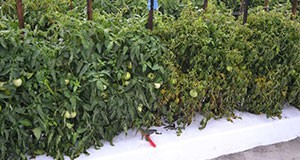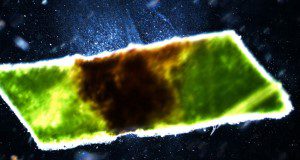Bacterial spot is one of the most detrimental diseases of tomato and is especially severe in the southeast United States when weather conditions (high temperature, high humidity, and rain) become conducive for disease development. This new 8-page publication of the UF/IFAS Plant Pathology Department presents updated information about the causal pathogen and management of bacterial spot on tomato in Florida. Written by Amanda Strayer-Scherer, Ying-Yu Liao, Peter Abrahamian, Sujan Timilsina, Mathews Paret, Tim Momol, Jeff Jones, and Gary Vallad.
https://edis.ifas.ufl.edu/pp353
Tag: Jeff Jones
The Good, the Bad, and the Ugly: What the Future Could Hold for Bs2 Tomatoes
 Bs2 tomatoes are transgenic tomatoes that have been engineered to contain the Bs2 gene from pepper. As such, they are considered a genetically modified (GM) food, or a genetically modified organism (GMO). Numerous trials conducted by University of Florida researchers have shown the benefits of these cultivars for bacterial spot disease management, and growers and industry members recognize the potential for Bs2 tomatoes to make Florida tomato production more sustainable. This 4-page fact sheet discusses the benefits that might be realized by the adoption of Bs2 tomato varieties, and the challenges standing in the way of their commercial production. Written by S. F. Hutton, J. W. Scott, J. B. Jones, R. E. Stall, G. E. Vallad, B. J. Staskawicz, and D. M. Horvath , and published by the UF Department of Horticultural Sciences, April 2015.
Bs2 tomatoes are transgenic tomatoes that have been engineered to contain the Bs2 gene from pepper. As such, they are considered a genetically modified (GM) food, or a genetically modified organism (GMO). Numerous trials conducted by University of Florida researchers have shown the benefits of these cultivars for bacterial spot disease management, and growers and industry members recognize the potential for Bs2 tomatoes to make Florida tomato production more sustainable. This 4-page fact sheet discusses the benefits that might be realized by the adoption of Bs2 tomato varieties, and the challenges standing in the way of their commercial production. Written by S. F. Hutton, J. W. Scott, J. B. Jones, R. E. Stall, G. E. Vallad, B. J. Staskawicz, and D. M. Horvath , and published by the UF Department of Horticultural Sciences, April 2015.
http://edis.ifas.ufl.edu/hs1259
“Earlyploid”: Tetraploid Annual Ryegrass (SSAGR355/AG364)
 Earlyploid, developed at the UF/IFAS North Florida Research and Education Center, is a large-seeded, upright, early forage-producing and early maturing annual ryegrass. Regional variety trials show it is the earliest tetraploid ryegrass cultivar available commercially. It offers excellent disease resistance and sufficient cold tolerance to be grown successfully in the southern annual ryegrass region of the U.S. This 1-page fact sheet was written by A.R. Blount, G.M. Prine, C.L. Mackowiak, K.E. Kenworthy, J.C. Jones, and P.E. Reith, and published by the UF Department of Agronomy, October 2011.
Earlyploid, developed at the UF/IFAS North Florida Research and Education Center, is a large-seeded, upright, early forage-producing and early maturing annual ryegrass. Regional variety trials show it is the earliest tetraploid ryegrass cultivar available commercially. It offers excellent disease resistance and sufficient cold tolerance to be grown successfully in the southern annual ryegrass region of the U.S. This 1-page fact sheet was written by A.R. Blount, G.M. Prine, C.L. Mackowiak, K.E. Kenworthy, J.C. Jones, and P.E. Reith, and published by the UF Department of Agronomy, October 2011.
http://edis.ifas.ufl.edu/ag364
“Ocala”: A New Diploid Annual Ryegrass for the Southern U.S. (SSAGR356/AG365)
 Ocala, a new UF annual ryegrass, has excellent disease resistance and sufficient cold tolerance to be grown successfully in the southern annual ryegrass region of the U.S. It is a well-adapted, diploid annual ryegrass population. Parentage includes several advanced experimental annual ryegrass populations for Florida and Nebraska. This 1-page fact sheet was written by A.R. Blount, G.M. Prine, K.E. Kenworthy, P. Mislevy, J.C. Jones, and P.E. Reith, and published by the UF Department of Agronomy, October 2011.
Ocala, a new UF annual ryegrass, has excellent disease resistance and sufficient cold tolerance to be grown successfully in the southern annual ryegrass region of the U.S. It is a well-adapted, diploid annual ryegrass population. Parentage includes several advanced experimental annual ryegrass populations for Florida and Nebraska. This 1-page fact sheet was written by A.R. Blount, G.M. Prine, K.E. Kenworthy, P. Mislevy, J.C. Jones, and P.E. Reith, and published by the UF Department of Agronomy, October 2011.
http://edis.ifas.ufl.edu/ag365
PP62/PP107 Common Bacterial Blight of Snap Bean in Florida
Revised! PP-62, a 3-page illustrated fact sheet by Shouan Zhang, Aaron J. Palmateer, Ken Pernezny and Jeffrey B. Jones, describes this most frequently encountered bacterial disease of snap bean in Florida, its symptoms, cause and disease cycle, and control. Published by the UF Department of Plant Pathology, February 2009.
http://edis.ifas.ufl.edu/PP107
PP255/PP171 Host-Plant Resistance and Management of Bacterial Spot of Pepper
PP-255, a 3-page illustrated fact sheet by Ken Pernezny, Jeff Jones, Russell Nagata, and Nikol Havranek, describes the developments in the campaign to develop cultivars resistant to Xanthomonas euvesicatoria. Published by the UF Department of Plant Pathology, June 2008.
http://edis.ifas.ufl.edu/PP171
